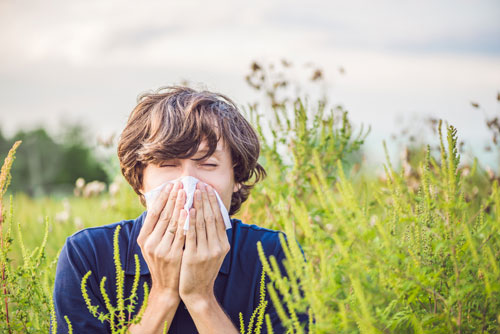What you should know about Allergic Rhinitis
“Allergy” is the potential for your body’s immune system to react in a strange way to substances in the air that are usually harmless. There are many of these substances. Some of the most common ones found in the environment you live in are pollen, mold spores and animal dander. The substances that make you react are called “allergens.” “Rhinitis” is an inflammation of the lining of the nose. So “allergic rhinitis” means: that you develop the symptoms of a runny nose, congestion, sneezing, and/or itching in response to certain allergens.

Not all rhinitis is caused by allergies. An infection, medications, other diseases, chemicals or other irritants in your environment call cause rhinitis. You can inhale them or they can be in your food and medications. Rhinitis can also be a result of your hormones or the use of the illegal narcotic cocaine. If you have more than one type of rhinitis causing your symptoms, you are said to have mixed rhinitis. Your doctor will confirm whether or not your rhinitis is caused by allergies by asking you questions about your symptoms and performing an allergy skin test.
The symptoms of allergic rhinitis are annoying and can severely interfere with your daily routine and quality of life. But they don’t have to. Many effective strategies are available to lessen or eliminate symptoms, and you’ve taken the first and most important step by visiting your doctor.
Avoiding Triggers
One of the most important and effective ways to alleviate symptoms is to avoid the allergens that cause them. While this is not always realistic or practical, the following information will teach you how to decrease your allergen exposure:
Pollen
Wind-pollinated trees, grasses and weeds are among the most common allergens. Since peak pollination seasons vary widely throughout the United States, be sure to check local authorities in your area or go to pollen.com to find out when pollen counts are at their highest. Generally, trees pollinate in early to mid spring, grasses in late spring and early summer, and weeds in late summer and early fall. The hours between 11:00 am and 3:00 pm are usually the worst. Keep windows closed and use air conditioning on the “indoor” cycle (ie, vents closed) during peak hours. Avoid using window and attic fans that pull pollen indoors. Avoid outdoor activities as much as possible and shower after being outdoors to remove pollen from skin and hair. Dry laundered clothes in a vented dryer, not outside.
Molds/Fungi
Outdoor mold spore counts are generally highest in late summer and early fall. Avoid walking through uncut fields, working with compost or dry soil, and raking leaves. Stay indoors during and immediately after rain and during other periods of high humidity. Use cleaning products containing bleach on sinks, shower stalls, and garbage pails, where mold is likely to grow. Avoid humidifiers, vaporizers, damp basements, attics and crawl spaces, and bathrooms and kitchens without vents or windows. Check air conditioners, coolers, refrigerator drip pans, moist wall spaces, carpet backing, and other areas where mold may grow.
Dust Mites
Dust mite feces (waste) are an important allergen in all but the driest climates. It is primarily found in bedding, upholstered furniture, carpeting and stuffed animals. If you are allergic to dust mites, avoid carpeting, especially where you sleep. Wear a face mask while cleaning the house and for about 15 minutes after. Use a vacuum cleaner equipped with a double-filtration system or at least a high-energy articulate air (HEP A) filter. Encase mattresses and pillows in zippered, allergen-proof covers. Wash bed linens in water heated to a minimum of 130″F at least every two weeks and dry them in a hot dryer. Choose plastic, leather and wood furniture instead of pieces covered in fabric.

